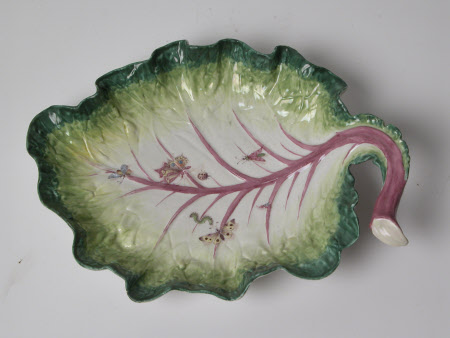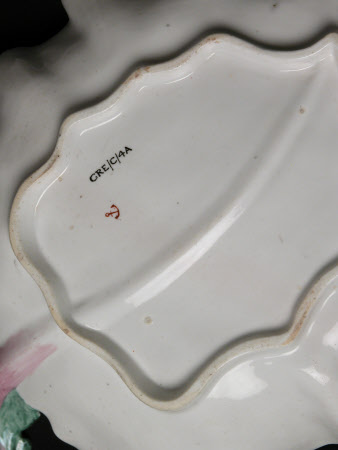Dish
Chelsea Porcelain Factory (1744-1769)
Category
Ceramics
Date
1756 - 1758
Materials
porcelain, polychrome enamels
Measurements
40 x 280 x 200 mm
Place of origin
Chelsea
Order this imageCollection
Greys Court, Oxfordshire
NT 195139.1
Summary
One of a pair of Chelsea Leaf dishes with stalk handle and raised puce veins. Painted with bugs, butterflies and other insects, with two-tone green borders, Red anchor mark, 1756-1758.
Full description
Similar dishes are described in the Chelsea porcelain factory sale catalogue, as on Tuesday, 25 March 1755, on the 14th day, lot 63 'Four fine old leaves, and two small cabbage leaves for desert'. The decoration of these Chelsea porcelain plates with botanical specimens was referred to in a contemporary advertisement in 1758 as 'Sir Hans Sloan's plants', and hence the moniker. Sir Hans Sloane (1660-1753) was physician to the Queen and a member of the Royal Society and College of Physicians. He founded the Chelsea Physic Garden when he leased it to the Worshipful Society of Apothecaries in 1712 and there grew many exotics and other plants cultivated for medicinal purposes. Sloane was in Jamaica for many years and some of his wealth derived the inheritance of his wife, an heiress of a Jamaican plantation. His collections formed the core of the future British Museum. Many of these plants, some exotics imported from other countries, were illustrated in a book published by Philip Miller, the Head Gardener at the Chelsea Physic Garden, as 'Figures of Plants', in 1756. The plants were engraved by Georg Dionysius Ehret. The plants depicted on the service at Greys Court have not been identified, nor have their sources. See also Sally Kevill-Davies, 'Sir Hans Sloane's Plants on Chelsea Porcelain', London, 2015.
Provenance
Gifted to the National Trust by Sir Felix and Lady Elizabeth Brunner, along with Greys Court House and Estate, 1969.
Marks and inscriptions
Base: Red anchor mark Base: Old inventory number
Makers and roles
Chelsea Porcelain Factory (1744-1769)

